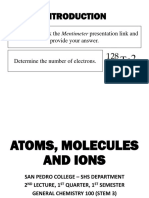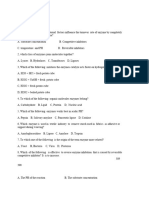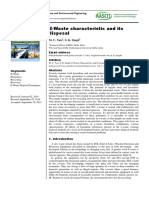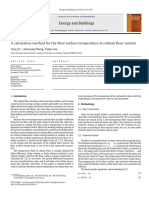Lesson 1 - Introduction
Uploaded by
Melvyn DarauayLesson 1 - Introduction
Uploaded by
Melvyn DarauayRepublic of the Philippines
CAGAYAN STATE UNIVERSITY
Carig Campus, Tuguegarao City
College of Engineering and Architecture
Course CHEM111E (Chemistry for Engineers)
Title of the
UNIT 1 – Fundamentals of Chemistry
Module
Module No. Module 1 - 1
Learning Objectives:
Learning At the end of this unit, the students will be able to:
Objectives A. Describe different ways to identify atoms.
B. Combine simple ions to write formulas and names of some ionic
compounds.
I. Atoms and Molecules
II. Chemical Formulas
Content
III. Ionic and Ionic Compounds
IV. Nomenclature of Compounds
Introduction:
This world around us is composed of all sorts of substances like bricks, concrete, wood,
metal, and many others. To understand and appreciate these substances we need to know what
atoms they composed of and how the atoms are attached and bonded to each other. We also need
to learn and understand chemical reactions to how initial substances are converted into another
substance. We use chemical reactions to create many useful products such as steel for cars and
buildings, ammonia for fertilizers, and chips for computers and electronics.
Since chemical reactions involve rearrangement of atoms, we need to know how many atoms
are present in a given samples of starting materials when we run a reaction. However, because
atoms are too small to count directly, we need an indirect technique to count them that is useful in
factories and laboratories. In this unit, we will learn how many atoms counted by weighing
samples of them and by chemical reactions.
I. ATOMS AND MOLECULES
Greek philosopher Democritus stated the belief that all matter consists of very small,
indivisible particles, which he named atomos (meaning uncuttable or indivisible).
The postulates about the nature of matter on which Dalton’s atomic theory is based can
be summarized as follows:
Elements are composed of extremely small particles called atoms.
All atoms of a given element are identical, having the same size, mass, and chemical
properties. The atoms of one element are different from the atoms of all other elements.
Compounds are composed of atoms of more than one element. In any compound, the ratio of
Chemical Engineering Department Module 1-1: Page 1
Republic of the Philippines
CAGAYAN STATE UNIVERSITY
Carig Campus, Tuguegarao City
College of Engineering and Architecture
the numbers of atoms of any two of the elements present is either an integer or a simple
fraction.
A chemical reaction involves only the separation, combination, or rearrangement of atoms; it
does not result in their creation or destruction.
Law of definite proportions states
that different samples of the same
compound always contain its constituent
elements in the same proportion by mass.
Different compounds are made up of the
same elements but differ in the number of
atoms of each kind that combine.
The law of multiple proportions For example, carbon forms two stable
states that if two elements can combine compounds with oxygen, namely, carbon
to form more than one compound, the monoxide and carbon dioxide.
masses of one element that combine with
a fixed mass of the other element are in
ratios of small whole numbers.
law of conservation of mass states
that The total mass of substances
present at the end of a chemical process
is the same as the mass of substances
present before the process took place.
A. Structure of the Atom
Through research and experimentation, scientists have found out that an atom is composed of
three elementary particles: proton, electron, and neutron. The proton has a positive charge, the
electron has a negative charge, and the neutron has no charge. Protons and neutrons are located
in the nucleus, a small region at the center of the atom, while electrons are spread out about the
nucleus at some distance from it.
The table below shows the characteristics of the atom’s subatomic particle.
Chemical Engineering Department Module 1-1: Page 2
Republic of the Philippines
CAGAYAN STATE UNIVERSITY
Carig Campus, Tuguegarao City
College of Engineering and Architecture
Mass
Particle Atomic Mass Charge
Grams
Units
Electron 9.109383 x 10 -28 0.0005485799 -1
Proton 1.672622 x 10 -24 1.007285 +1
Neutron 1.674927 x 10 -24 1.008665 0
B. Atomic Number, Mass Number, and Isotopes
All atoms can be identified according to the number of protons and neutrons they contain.
The atomic number (Z) is the number of protons in
the nucleus of each atom of an element. In a neutral
atom the number of protons is equal to the
number of electrons; therefor the atomic number
also indicates the number of electrons present in the
atom. Example:
23
The mass number (A) is the sum of the number of 11𝑁𝑎
neutrons and protons present in the nucleus of an Atomic number = 11
atom of an element. Except for the most common form Mass number = 23
of hydrogen, because it has has one proton and no No. of protons = 11
neutrons, all atomic nuclei contain both protons and No. of electrons = 11
neutrons. In general, the mass number is given by No. of neutron = 23 – 11 = 12
mass number = number of protons + number of
neutrons
= atomic number + number of neutrons
Some atoms of a given element do not all have the
Example:
same mass. Most elements have two or more
isotopes. Isotopes are elements that have the 1
1𝐻 Hydrogen, has one proton and
same atomic number but different mass no neutrons.
numbers. 2
1𝐻 The deuterium isotope contains
one proton and one neutron.
3
1𝐻tritium has one proton and two
neutrons
Chemical Engineering Department Module 1-1: Page 3
Republic of the Philippines
CAGAYAN STATE UNIVERSITY
Carig Campus, Tuguegarao City
College of Engineering and Architecture
C. Molecules
A molecule is a group of at least two atoms in a definite arrangement held together by
chemical forces (also called chemical bonds). A molecule may comprise atoms of the same element
or atoms of two or more elements joined in a fixed ratio, in accordance with the law of definite
proportions. Thus, a molecule is not necessarily a compound, which, by definition, is made up of
two or more elements. Hydrogen gas, H2, for example, is a pure element, but it composed of
molecules made up of two H atoms each.
The hydrogen molecule, symbolized as H2, is called a diatomic molecule because
it contains only two atoms. Other elements that usually exist as diatomic molecules are nitrogen
(N2) and oxygen (O2), as well as the Group 7A elements—fluorine (F2), chlorine (Cl2), bromine
(Br2), and iodine (I2). Of course, a diatomic molecule can contain atoms of different elements.
Molecules comprising more than two atoms are called polyatomic molecules. Like ozone,
water (H2O) and ammonia (NH3) are polyatomic molecules.
Self-learning Assessment 1:
1. The atoms of elements A (blue)
and B (orange) form two
compounds shown here. Do
these compounds obey the law
of multiple proportions?
2. Give the number of protons, neutrons, and electrons in each of the following species:
(a) 20 11Na, (b) 22 11Na, (c) 17O, and (d) carbon-14.
3. One isotope of a metallic element has mass number 65 and 35 neutrons in the nucleus. The
cation derived from the isotope has 28 electrons. Write the symbol for this cation.
II. CHEMICAL FORMULAS
A chemical formula is used by chemist to express the composition of molecules and ionic
compounds in terms of chemical symbols. By composition we mean not only the elements present
but also the ratios or percentages in which the atoms are combined. Here we have three types of
formulas: molecular formulas, empirical formulas and structural formulas. We will only focus on
the first two because structural formulas will be dealt on organic chemistry.
Chemical Engineering Department Module 1-1: Page 4
Republic of the Philippines
CAGAYAN STATE UNIVERSITY
Carig Campus, Tuguegarao City
College of Engineering and Architecture
Example:
A molecular formula shows the exact
number of atoms of each element in the The molecular formula of hydrogen
smallest unit of a substance. peroxide, a substance used as an
antiseptic and as a bleaching agent for
textiles and hair, is H2O2. This formula
indicates that each hydrogen peroxide
molecule consists of two hydrogen atoms
and two oxygen atoms.
The empirical formula tells us
which elements are present and the
simplest whole-number ratio of their The empirical formula of hydrogen
atoms, but not necessarily the actual peroxide is HO.
number of atoms in a given molecule.
The structural formula, which
shows how atoms are bonded to one
another in a molecule.
Example 2.1:
Problem: Write the empirical formulas for the following molecules:
(a) acetylene (C2H2), which is used in welding torches;
(b) glucose (C6H12O6), a substance known as blood sugar; and
(c) nitrous oxide (N2O), a gas that is used as an anesthetic gas (“laughing gas”) and as an
aerosol propellant for whipped creams
Strategy
Recall that to write the empirical formula, we need to make sure that the subscripts in the
molecular formula must be converted to the smallest possible whole numbers.
Solution
(a) There are two carbon atoms and two hydrogen atoms in acetylene. So we can divide the
subscripts by 2, so that we will obtain the empirical formula CH.
(b) In glucose there are 6 carbon atoms, 12 hydrogen atoms, and 6 oxygen atoms.
The smallest possible whole number is 6 therefore dividing the subscripts by 6; we obtain the
empirical formula CH2O. Note that if we had divided the subscripts by 3, we would have
obtained the formula C2H4O2. Although the ratio of carbon to hydrogen to oxygen atoms in
C2H4O2 is the same as that in C6H12O6 (1:2:1), C2H4O2 is not the simplest formula because its
subscripts are not in the smallest whole-number ratio.
Chemical Engineering Department Module 1-1: Page 5
Republic of the Philippines
CAGAYAN STATE UNIVERSITY
Carig Campus, Tuguegarao City
College of Engineering and Architecture
(c) Because the subscripts in N2O are already the smallest possible whole numbers, the
empirical formula for nitrous oxide is the same as its molecular formula.
Self-learning Assessment 2:
1. Write the empirical formula for caffeine (C8H10N4O2), a stimulant found in tea and coffee
III. IONS AND IONIC COMPOUNDS
An ion is an atom or a group of atoms that has a net positive or negative charge. The
number of positively charged protons present in the nucleus of an atom remains the same during
ordinary chemical changes (called chemical reactions), but negatively charged electrons may be
lost or gained.
The loss of one or more electrons from a neutral atom results in a cation, an ion with a net
positive charge. For example, a potassium atom (K) can readily lose an electron to become a
potassium cation, which is represented by K+. On the other hand, an anion is an ion whose net
charge is negative due to an increase in the number of electrons. A chlorine atom (Cl), for instance,
can gain an electron to become the chloride ion Cl-.
For ionic compounds to be electrically neutral, the sum of the charges on the cation and
anion in each formula unit must be zero. If the charges on the cation and anion are numerically
different, we apply the following rule to make the formula electrically neutral: The subscript of
the cation is numerically equal to the charge on the anion, and the subscript of the
anion is numerically equal to the charge on the cation. If the charges are numerically equal,
then no subscripts are necessary. This rule follows from the fact that because the formulas of ionic
compounds are usually empirical formulas, the subscripts must always be reduced to the smallest
ratios.
Let us consider some examples.
The potassium cation K+ and the bromine anion Br- is combined
Potassium
to form the ionic compound potassium bromide.
Bromide.
The sum of the charges is (+1) + (-1) = 0, therefore no subscripts
are necessary. The formula is KBr.
The zinc cation Zn2+ and the iodine anion I- is combined to form
zinciodide.
Zinc Iodide.
The sum of the charges of one Zn2+ ion and one I- ion is +2 + (-1)
= +1. To make the charges add up to zero we multiply the -1
charge of the anion by 2 and add the subscript “2” to the symbol
Chemical Engineering Department Module 1-1: Page 6
Republic of the Philippines
CAGAYAN STATE UNIVERSITY
Carig Campus, Tuguegarao City
College of Engineering and Architecture
for iodine. Therefore the formula for zinc iodide is ZnI2.
Aluminum Oxide. The cation is Al3+ and the oxygen anion is O2-. The following
diagram helps us determine the subscripts for the compound
formed by the cation and the anion:
The sum of the charges is 2(+3) + 3(-2) = 0. Thus, the formula for
aluminum oxide is Al2O3
Self-learning Assessment 3:
Write the formulas of the following ionic compounds:
(a) chromium sulfate (containing the Cr3+ and SO42- ions)
(b) Titanium oxide (containing the Ti4+ and O2- ions).
IV. NOMENCLATURE OF COMPOUNDS
To begin our discussion of chemical nomenclature, the naming of chemical compounds, we
must first differentiate inorganic and organic compounds. Organic compounds contain carbon,
usually in combination with elements such as hydrogen, oxygen, nitrogen, and sulfur. All other
compounds are classified as inorganic compounds. But some carbon-containing compounds,
such as carbon monoxide (CO), carbon dioxide (CO2), carbon disulfde (CS2), compounds containing
the cyanide group (CN-), and carbonate (CO32-) and bicarbonate (HCO3-) groups are considered to
be inorganic compounds.
To organize and simplify our course into naming compounds, we can divide inorganic
compounds into four categories: ionic compounds, molecular compounds, acids and bases, and
hydrates.
A. Ionic Compounds
From the previous topic, we learned that ionic compounds are made up of cations (positive ions)
and anions (negative ions).
With the important exception of the
ammonium ion, NH4 +, all cations of
interest to us are derived from metal
atoms. Metal cations take their
names from the elements.
Chemical Engineering Department Module 1-1: Page 7
Republic of the Philippines
CAGAYAN STATE UNIVERSITY
Carig Campus, Tuguegarao City
College of Engineering and Architecture
For example, NaCl is sodium chloride. The
anion is named by taking the first part of the
Many ionic compounds are binary
element name (chlorine) and adding “-ide.”
compounds, or compounds formed
from just two elements. For binary
compounds, the first element named
is the metal cation, followed by the
nonmetallic anion.
For example, hydroxide (OH-) and cyanide (CN-
Ternary compounds are ionic
). Thus, the compounds LiOH and KCN are
compounds consisting of three
named lithium hydroxide and potassium
elements.
cyanide, respectively.
An older nomenclature system that is
still in limited use assigns the ending
“-ous” to the cation with fewer
The names of the compounds that these iron
positive charges and the ending “-ic”
ions form with chlorine would thus be
to the cation with more positive
charges:
Note: This method of naming ions
has some distinct limitations. First, Thus, the ferric ion is Fe3+, but the cation of
the “-ous” and “-ic” suffixes do not copper named cupric has
provide information regarding the the formula Cu2+.
actual charges of the two cations
involved.
Some metallic elements can assume For example, manganese (Mn) atoms can
three or more different positive assume several different positive charges:
charges in compounds. Therefore, it
has become increasingly common to
designate different cations with
Roman numerals. This is called the
Stock system. In this system, the These names are pronounced “manganese-two
Roman numeral I indicates one oxide,” “manganese-three oxide,” and
positive charge, II means two “manganese-four oxide.”
positive charges, and so on.
B. Molecular Compounds
Molecular compounds usually consist of nonmetallic elements. Many molecular compounds
are binary compounds and are similar to naming binary ionic compounds.
We place the name of the first element in the formula first, and the second element is named by
adding -ide to the root of the element name. Some examples are
Chemical Engineering Department Module 1-1: Page 8
Republic of the Philippines
CAGAYAN STATE UNIVERSITY
Carig Campus, Tuguegarao City
College of Engineering and Architecture
Confusion in naming the compounds is avoided by the use of Greek prefixes to denote the number
of atoms of each element present (Table 2.4). Consider the following examples:
Exceptions to the use of Greek prefixes are molecular compounds containing hydrogen.
Traditionally, in most cases, many of these compounds are called either by their common,
nonsystematic names or by names that do not specifically indicate the number of H atoms present:
The following guidelines are helpful in naming
compounds with prefxes:
• The prefx “mono-” may be omitted for the first
element.
For example, PCl3 is named phosphorus
trichloride, not monophosphorus trichloride.
Thus, the absence of a prefix for the first
element usually means there is only one atom
of that element present in the molecule.
• For oxides, the ending “a” in the prefix is
sometimes omitted.
For example, N2O4 may be called dinitrogen
tetroxide rather than dinitrogen tetraoxide.
Note that even the order of writing the elements in the formulas for hydrogen compounds is
irregular. In water and hydrogen sulfide, H is written first, whereas it appears last in the other
compounds.
Chemical Engineering Department Module 1-1: Page 9
Republic of the Philippines
CAGAYAN STATE UNIVERSITY
Carig Campus, Tuguegarao City
College of Engineering and Architecture
Example 4.1 :
Problem:
Name the following molecular compounds:
(a) SiCl4 (b) P4O10.
Strategy
We refer to Table 2.4 for prefixes.
In (a) there is only one Si atom so we do not use the prefx “mono.”
Solution
(a) Because there are four chlorine atoms present, the compound is silicon tetrachloride.
(b) There are four phosphorus atoms and ten oxygen atoms present, so the compound is
tetraphosphorus decoxide. Note that the “a” is omitted in “deca.”
Example 4.22.8
Problem:
Write chemical formulas for the following molecular compounds:
(a) carbon disulfide and (b) disilicon hexabromide.
Strategy
Here we need to convert prefixes to numbers of atoms (see Table 2.4). Because
there is no prefix for carbon in (a), it means that there is only one carbon atom present.
Solution
(a) Because there are two sulfur atoms and one carbon atom present, the
formula is CS2.
(b) There are two silicon atoms and six bromine atoms present, so the formula is Si2Br6.
Self-learning Assessment 2:
1. Name the following molecular compounds: (a) NF3 and (b) Cl2O7.
2. Write chemical formulas for the following molecular compounds:
(a) sulfur tetrafluoride and (b) dinitrogen pentoxide.
References:
1. Zumdhal, Steven S., Zumdhal, Susan A.(2012). Chemisrty: An Atoms First Approach
(International Edition). Brooks/Cole, Cengage Learning
2. Chang, Raymond (2010). CHEMISTRY (10th ed). McGraw-Hill
Chemical Engineering Department Module 1-1: Page 10
You might also like
- Chapter 4 Assessment, SOLUTION MANUAL The Structure of The Atom100% (3)Chapter 4 Assessment, SOLUTION MANUAL The Structure of The Atom14 pages
- CHEM111E (Chemistry For Engineers) : UNIT 1 - Fundamentals of Chemistry Module 1 - 1No ratings yetCHEM111E (Chemistry For Engineers) : UNIT 1 - Fundamentals of Chemistry Module 1 - 158 pages
- Kami Export - Topic 1 Formulae, Equations and Amount of SubstanceNo ratings yetKami Export - Topic 1 Formulae, Equations and Amount of Substance28 pages
- CHEM 110 - First Term - 2024 - 2025 - Chapter 2No ratings yetCHEM 110 - First Term - 2024 - 2025 - Chapter 241 pages
- Campbell Lecture Notes Chemistry of LifeNo ratings yetCampbell Lecture Notes Chemistry of Life42 pages
- 1 Formulae, Equations and Amount of SubstanceNo ratings yet1 Formulae, Equations and Amount of Substance34 pages
- Chapter 2 Chemistry For Engineers Final Module 2No ratings yetChapter 2 Chemistry For Engineers Final Module 226 pages
- Unit 1 Principles of Chemistry: Atomic StructureNo ratings yetUnit 1 Principles of Chemistry: Atomic Structure10 pages
- Atoms and Molecules Class 9 Notes - Chapter 3 HighlightsNo ratings yetAtoms and Molecules Class 9 Notes - Chapter 3 Highlights1 page
- Chapter 02 - Atoms - Molecules - and IonsNo ratings yetChapter 02 - Atoms - Molecules - and Ions54 pages
- Fundamentals of Inorganic Chemistry LectNo ratings yetFundamentals of Inorganic Chemistry Lect65 pages
- Topic 2 Atomic Structure and Periodic TableNo ratings yetTopic 2 Atomic Structure and Periodic Table33 pages
- The Structure of The Atom - Boundless ChemistryNo ratings yetThe Structure of The Atom - Boundless Chemistry13 pages
- Eastern Samar National Comprehensive High School Chemistry 1No ratings yetEastern Samar National Comprehensive High School Chemistry 13 pages
- 2.1! Atoms, Isotopes, Ions, And Molecules - The Building BlocksNo ratings yet2.1! Atoms, Isotopes, Ions, And Molecules - The Building Blocks18 pages
- General Chemistry CHE 101: Atoms, Molecules and IonsNo ratings yetGeneral Chemistry CHE 101: Atoms, Molecules and Ions60 pages
- General Chemistry: Atoms First: The Structure and Stability of AtomsNo ratings yetGeneral Chemistry: Atoms First: The Structure and Stability of Atoms44 pages
- Bi112 Ch 2 Chem Context Life in Class Exam Prep Assignment[1]No ratings yetBi112 Ch 2 Chem Context Life in Class Exam Prep Assignment[1]16 pages
- Atoms and Molecules Class 9 Notes Chapter 3No ratings yetAtoms and Molecules Class 9 Notes Chapter 37 pages
- Unit 1 Molecules Their Interaction Relevant To Biology CSIR UGC NET Life Sciences100% (1)Unit 1 Molecules Their Interaction Relevant To Biology CSIR UGC NET Life Sciences5 pages
- QUARTER 1 LESSON 2 Atom Ions and MoleculesNo ratings yetQUARTER 1 LESSON 2 Atom Ions and Molecules60 pages
- 2023 Lesson Notes 2 - Atoms Molecules IonsNo ratings yet2023 Lesson Notes 2 - Atoms Molecules Ions7 pages
- 9.5 Determining The Number of Protons, Electrons, and NeutronsNo ratings yet9.5 Determining The Number of Protons, Electrons, and Neutrons5 pages
- Kami Export - Atomic Structure and Periodic TableNo ratings yetKami Export - Atomic Structure and Periodic Table33 pages
- S2 Cfe Science Acids & Alkalis: High Acidity Low AcidityNo ratings yetS2 Cfe Science Acids & Alkalis: High Acidity Low Acidity4 pages
- 3 Surface Modification and Its Influence On The Microstructure and Creep Resistance of Nickel Based Superalloy Rene 77No ratings yet3 Surface Modification and Its Influence On The Microstructure and Creep Resistance of Nickel Based Superalloy Rene 774 pages
- Presentation On Pretreatment Scouring BleachingNo ratings yetPresentation On Pretreatment Scouring Bleaching15 pages
- Us2 S 142 Periodic Table Search and Find Activity Sheet English - Ver - 7No ratings yetUs2 S 142 Periodic Table Search and Find Activity Sheet English - Ver - 74 pages
- Electromagnetic Applications: Powder Metallurgy Meets Electro MagneticsNo ratings yetElectromagnetic Applications: Powder Metallurgy Meets Electro Magnetics12 pages
- Derivation of Formula For Water Tank EquationNo ratings yetDerivation of Formula For Water Tank Equation4 pages
- Design and Analysis of Steam Turbine BladesNo ratings yetDesign and Analysis of Steam Turbine Blades7 pages
- Appendix II - Review of Solution Preparation - 2013 - Plant Tissue Culture PDFNo ratings yetAppendix II - Review of Solution Preparation - 2013 - Plant Tissue Culture PDF3 pages
- Thoretical Questions of Electronic Properties of MaterialsNo ratings yetThoretical Questions of Electronic Properties of Materials7 pages
- E-Waste Characteristic and Its Disposal: M. C. Vats, S. K. SinghNo ratings yetE-Waste Characteristic and Its Disposal: M. C. Vats, S. K. Singh13 pages
- CH 04 Chemical Bonding Molecular StructureNo ratings yetCH 04 Chemical Bonding Molecular Structure4 pages
- Chapter 4 Assessment, SOLUTION MANUAL The Structure of The AtomChapter 4 Assessment, SOLUTION MANUAL The Structure of The Atom
- CHEM111E (Chemistry For Engineers) : UNIT 1 - Fundamentals of Chemistry Module 1 - 1CHEM111E (Chemistry For Engineers) : UNIT 1 - Fundamentals of Chemistry Module 1 - 1
- Kami Export - Topic 1 Formulae, Equations and Amount of SubstanceKami Export - Topic 1 Formulae, Equations and Amount of Substance
- Atoms and Molecules Class 9 Notes - Chapter 3 HighlightsAtoms and Molecules Class 9 Notes - Chapter 3 Highlights
- Eastern Samar National Comprehensive High School Chemistry 1Eastern Samar National Comprehensive High School Chemistry 1
- 2.1! Atoms, Isotopes, Ions, And Molecules - The Building Blocks2.1! Atoms, Isotopes, Ions, And Molecules - The Building Blocks
- General Chemistry CHE 101: Atoms, Molecules and IonsGeneral Chemistry CHE 101: Atoms, Molecules and Ions
- General Chemistry: Atoms First: The Structure and Stability of AtomsGeneral Chemistry: Atoms First: The Structure and Stability of Atoms
- Bi112 Ch 2 Chem Context Life in Class Exam Prep Assignment[1]Bi112 Ch 2 Chem Context Life in Class Exam Prep Assignment[1]
- Unit 1 Molecules Their Interaction Relevant To Biology CSIR UGC NET Life SciencesUnit 1 Molecules Their Interaction Relevant To Biology CSIR UGC NET Life Sciences
- 9.5 Determining The Number of Protons, Electrons, and Neutrons9.5 Determining The Number of Protons, Electrons, and Neutrons
- Chemistry 101: Elements, Compounds, and ReactionsFrom EverandChemistry 101: Elements, Compounds, and Reactions
- S2 Cfe Science Acids & Alkalis: High Acidity Low AcidityS2 Cfe Science Acids & Alkalis: High Acidity Low Acidity
- 3 Surface Modification and Its Influence On The Microstructure and Creep Resistance of Nickel Based Superalloy Rene 773 Surface Modification and Its Influence On The Microstructure and Creep Resistance of Nickel Based Superalloy Rene 77
- Us2 S 142 Periodic Table Search and Find Activity Sheet English - Ver - 7Us2 S 142 Periodic Table Search and Find Activity Sheet English - Ver - 7
- Electromagnetic Applications: Powder Metallurgy Meets Electro MagneticsElectromagnetic Applications: Powder Metallurgy Meets Electro Magnetics
- Appendix II - Review of Solution Preparation - 2013 - Plant Tissue Culture PDFAppendix II - Review of Solution Preparation - 2013 - Plant Tissue Culture PDF
- Thoretical Questions of Electronic Properties of MaterialsThoretical Questions of Electronic Properties of Materials
- E-Waste Characteristic and Its Disposal: M. C. Vats, S. K. SinghE-Waste Characteristic and Its Disposal: M. C. Vats, S. K. Singh

























































































